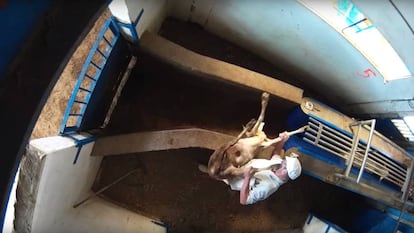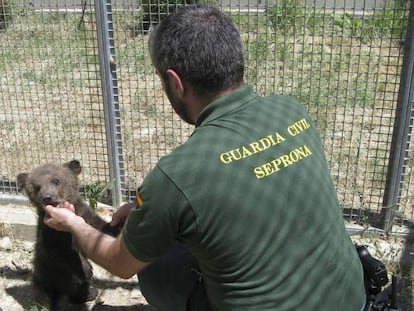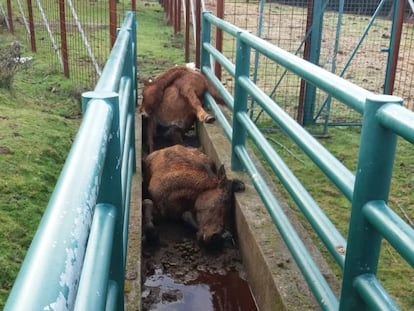Video: Activists expose shocking animal abuse at Madrid slaughterhouse
Workers were caught beating and jumping on top of lambs thanks to hidden cameras placed inside the facility by the environmental association Equalia
The images are compelling: lambs being thrown around, kicked and beaten, and a worker repeatedly jumping on top of them. Some of the animals are unable to stand, yet pass through to the production chain, ready for consumption.
According to images shared with this newspaper by the environmental association Equalia, these scenes are taking place inside Cárnicas Salvanés S.L., a slaughterhouse located in Villarejo de Salvanés, in the southeast of the Madrid region.
The images show that some animals are not stunned before being killed
On Monday, Equalia filed a criminal complaint against this business at a court in Leganés, accusing its owners of violating European animal welfare law and finding inadequate sanitary conditions at the facilities. The company denies the accusations.
The footage begins with a drone-captured image that shows the location of the slaughterhouse in Villarejo de Salvanés. At the family business, which is run by three brothers, lambs, sheep, goats and cows are slaughtered and subsequently put on the market for consumption in Madrid and parts of Toledo.
Until the beginning of 2019, the company held a Halal certificate, meaning that within the same slaughterhouse, animals are separated and depending on the final destination of the meat, they are either stunned or not (when the Islamic tradition is followed) before being slaughtered. Throughout this year, all animals should have been stunned to avoid unnecessary suffering.
One of them was hung while conscious for up to half-an-hour
David Herrero, Equalia
But hidden cameras captured what was happening between June and early September. The images show that some animals are not stunned before being killed. In the video, a sheep is seen suffering an entire night without being slaughtered.
“The slaughterman shirks his duties, so that some lambs pass through production without their blood being properly drained and are hung up while still alive with the rest of the dead animals,” explains David Herrero, general coordinator of Equalia, which has launched similar campaigns against slaughterhouses in Segovia and Ávila. “One of them was hung while conscious for up to half-an-hour, at which point the image of the animal is lost. We don’t know if it was skinned alive
The images show sheep that are ill or cannot stand on their legs, being taken to the conveyor belt to enter the bleeding area. One of them had been suffering for an entire night, the footage shows. “It was 10 hours before it was taken to the slaughter zone,” says Herrero. The law states that an animal that cannot walk will not be transported to the place of slaughter, and will instead be slaughtered on the spot, without moving it or, evidently, throwing it.
Other images show a worker attaching identity tags to several lambs inside the slaughterhouse. The regulations specify that all animals must already have this identification by the time they enter the enclosure, otherwise there is a risk of losing traceability.
“That is impossible. It can’t be. There are official veterinarians here. When animals enter the slaughterhouse, they have to come with their paperwork in order. If any are missing, they are processed through the Agriculture Ministry. And if any animal is not identified, it is thrown away, it is seized. Yesterday [Monday] there were two animals that didn’t have an ear tag and they were thrown away [sic].” explains Julián Rangel, manager of Cárnicas Salvanés. “It all depends on the context. A few isolated images can be interpreted any way you like,” he added, denying that his company fails to comply with animal welfare regulations or that sanitation conditions are deficient.
It all depends on the context. A few isolated images can be interpreted any way you like
Julián Rangel, slaughterhouse manager
In addition to exposing violations, Equalia is conducting a campaign for “a progressive implementation of CCTV in slaughterhouses” in order to aid the proper enforcement of animal welfare and food safety regulations. “We ask for them to be installed wherever live animals are handled, and for the images to be stored for one month in strict compliance with data-protection legislation. Also, we ask that these images be reviewed by the same operator or by the food-safety service of the Madrid regional government.” This system, Herrero assures, has already been implemented in places including England, Scotland and Israel.
Beyond the installation of closed-circuit cameras, “what is evident is that the legislation needs to be tightened,” says Laura Duarte, the new president of the animal-rights party Pacma. Duarte notes that thanks to the work of associations such as Equalia, it is at least possible to “prove that all of this is really happening.”
“Stunning requires a minimum amount of time, but because the production chain goes so fast, most of the time the animals are fully conscious. The truth is that even the little legislation that does exist is not being complied with,” she explains.
Madrid regional officials hold that the compulsory installation of CCTV is a measure that must be taken “at the national level.”
“The slaughterhouses in the Madrid region are under the control of the Official Veterinarians of the General Directorate of Public Health; there are daily inspections of the slaughtered animals, of the sanitary conditions at the facilities, and of the slaughtering process,” explains a source at the Madrid Health Department.
In addition to the daily inspections, audits are also carried out to check the working procedures by slaughterhouse operators, who “must have a self-monitoring system in place based on hazard analysis and critical control points, including hygiene and animal welfare aspects.” In Cárnicas Salnanés, that audit was carried out in August.
English version by Alicia Kember.
Tu suscripción se está usando en otro dispositivo
¿Quieres añadir otro usuario a tu suscripción?
Si continúas leyendo en este dispositivo, no se podrá leer en el otro.
FlechaTu suscripción se está usando en otro dispositivo y solo puedes acceder a EL PAÍS desde un dispositivo a la vez.
Si quieres compartir tu cuenta, cambia tu suscripción a la modalidad Premium, así podrás añadir otro usuario. Cada uno accederá con su propia cuenta de email, lo que os permitirá personalizar vuestra experiencia en EL PAÍS.
¿Tienes una suscripción de empresa? Accede aquí para contratar más cuentas.
En el caso de no saber quién está usando tu cuenta, te recomendamos cambiar tu contraseña aquí.
Si decides continuar compartiendo tu cuenta, este mensaje se mostrará en tu dispositivo y en el de la otra persona que está usando tu cuenta de forma indefinida, afectando a tu experiencia de lectura. Puedes consultar aquí los términos y condiciones de la suscripción digital.
More information
Archived In
Últimas noticias
Most viewed
- Sinaloa Cartel war is taking its toll on Los Chapitos
- Oona Chaplin: ‘I told James Cameron that I was living in a treehouse and starting a permaculture project with a friend’
- Reinhard Genzel, Nobel laureate in physics: ‘One-minute videos will never give you the truth’
- Why the price of coffee has skyrocketed: from Brazilian plantations to specialty coffee houses
- Silver prices are going crazy: This is what’s fueling the rally











































